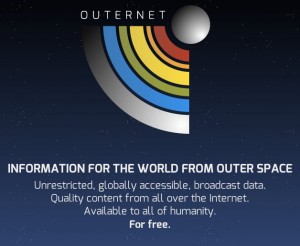There’s a new project in the works, Outernet, that aspires to bring the international accessibility of shortwave radio along with the versatility of the Internet. Outernet’s goal is stated on their website:

“By leveraging datacasting technology over a low-cost satellite constellation, Outernet is able to bypass censorship, ensure privacy, and offer a universally-accessible information service at no cost to global citizens. It’s the modern version of shortwave radio, or BitTorrent from space.”
It’s a fascinating concept: deploy low-cost, CubeSat satellites which broadcast data in a way that it should be accessible to anyone with a wi-fi enabled device such as smart phone or computer. Specifically, Outernet states that they will be using, “globally-accepted, standards-based protocols, such as DVB, Digital Radio Mondiale, and UDP-based WiFi multicasting.”
(What? Did they say Digital Radio Mondiale? They did indeed.)
I’m all about freedom of and access to information, so I hope Outernet is successful. They’ve published an ambitious timeline with a goal of having CubeSats ready to deploy as soon as June of 2015. For more information, check out Outernet’s project page.

is the ieee paper of lantern is available
What?!? A free DRM satellite radio service that works like shortwave?! Sold! Who do I make the cheque out to?
–You got me all excited there, and then I read their mission statement, which says something quite a bit different: Outernet is going to broadcast random data files to a caching receiver in a totally unpredictable fashion without a schedule or a guide to the content! So it’s actually not a live radio service like shortwave, but it certainly COULD be if they wanted to do that. Last time I checked, the typical data rate of their satellite feed is 88 kilobits per second, and you still need a dish: http://status.outernet.is/
But even that is enough for 14 DRM audio channels at 6 kbps (and somewhat more at lower quality encoder settings): http://www.audioblog.iis.fraunhofer.com/xhe-aac/
However, instead of live news and talk radio they are trying to make some kind of one-way web browser. And the key word here is NON-REAL TIME: http://discuss.outernet.is/t/two-way-communication/640
In other words, they expect people who are living off the grid to send letters by snail mail to the uplink facility, requesting a broadcast of some particular file. And then it will be sent via satellite to a caching receiver, without any notification to the user, at some unpredictable time in the future. Then you have to pray you can find the file before it rotates out of the cache.
This is supposed be a substitute for the internet (!) — but they are transmiting the signal to Europe and North America where no one is going to use it because they already have internet access!! And this Lantern device which costs around $200 will only guarantee 2 Megabytes per day. Thats less than the size of a typical digital photo. You could carry more data to a remote village at faster speeds if you walked there with a hard drive in your pocket!
https://www.indiegogo.com/projects/lantern-one-device-free-data-from-space-forever#/story
Asking poor people to pay $200 for this just sounds like a scam: if you want to bring web services into remote areas, you are far better off spending $200 per user to build terrestrial mesh networks which run on solar power. And the money which is being spent to develop that data caching device would be better spent on a low cost DRM receiver:
This text broadcasting service is a terrible waste of a satellite feed that could be used to deliver a dozen or more live audio channels 24 hours a day. And the “Lantern” device is a vaporware product that is dependent on satellites which have not been launched. If Outernet could really deliver the dishless mobile satellite radio service which was originally implied, they would not need to beg for donations: independent broadcasters would be lining up to sponsor audio channels, and the sale of mobile receivers would cover the rest of their operating costs.
They can’t use wifi as we know it. By definition wifi is license free very low power. The low power means tht the frequencies can be reused (just like cellphones) in multiple locations. Compare that with an AM broadcast station, it has a lot of range and that means the frequency can’t be used for quite a distance.
If you use existing wifi frequencies to broadcast from a satellite, it wipes out those frequencies. They will be hitting a wide swatch of territory, making wifi unuseable. Even if wifi uses spread spectrum (I don’t know), it’s superimposing a vastly different thing on very local wifi. There’s a finite space for wifi, and using it for something like this is wasteful.
Now, thsi project could campaign for some allocation elsewhere, but then it means special receivers. And then, how is it different from existing satellite broadcasting? It’s nto the cost of a receiver that matters, it’s the cost of the uplink transmitter(s) and the satellites, which is why one has to pay for existing satellite broadcasting.
Michael